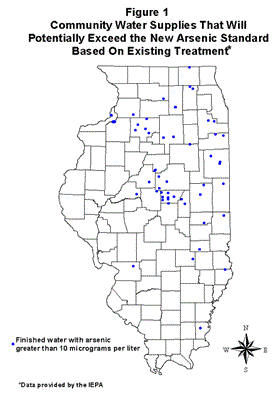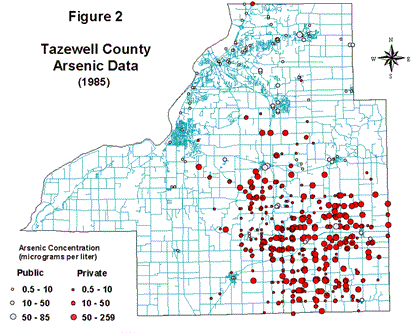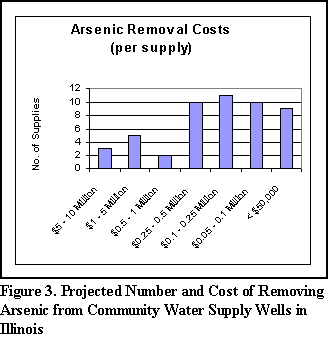Please note: Content marked as "ARCHIVED CONTENT" with an amber bar (above) is out of date and usually describes completed projects, and is provided only for informational purposes. Most of these programs, projects and services are discontinued.
Arsenic in Illinois Groundwater
Illinois Department of Natural Resources
Illinois Department of Public Health
Illinois Environmental Protection Agency
January 10, 2002
What are the Sources of Arsenic in Illinois Groundwater?
Arsenic is a naturally occurring element in the earth’s crust. Arsenic is found in the deep bedrock materials throughout Illinois, as well as in the shallow glacial materials that cover the northern two-thirds of the state. Arsenic is dissolved naturally from these materials and enters groundwater. Many other states have a similar problem.
Why is Arsenic a Concern?
Dissolved arsenic found in Illinois' groundwater is generally in inorganic form and is considered toxic. The Department of Health and Human Services lists arsenic as a known carcinogen. Ingesting inorganic arsenic over many years (chronic exposure) increases the risk of skin cancer and tumors of the bladder, kidney, liver, and lung. It has also been found to cause blood vessel damage, heart problems, darkening of the skin, and nervous system damage. Recently, the National Academy of Sciences (NAS) has reviewed the updated toxicological data base for arsenic and has determined that cancer risks from arsenic exposures are greater than previously estimated. This prompted a call to lower the drinking water standard for arsenic in order to protect human health.
About 35 percent of Illinois residents use groundwater for their water source. In addition, approximately 90 percent of rural citizens utilize groundwater from private wells for their source of water. In total, over four million Illinois residents use groundwater.
Regulation of Arsenic in Drinking Water
The national drinking water standard for arsenic has been 50 micrograms per liter (μg/L), which is 50 parts per billion. This standard was set in 1942. The World Health Organization has set a guideline of 10 μg/L. The United States Environmental Protection Agency (USEPA) recently evaluated the drinking water standard for arsenic and on October 30, 2001, USEPA recommended that the standard be lowered to 10 μg/L.
The new rule will be phased in such that compliance to the national drinking water standard for arsenic will be required by 2006 for all public water supplies. The Illinois Pollution Control Board has final say on Illinois’ adoption of the national standard and typically the national regulation is quickly adopted and made law in Illinois. It is anticipated that the adoption of the national standard in Illinois will be finalized before the end of the year. At that point, the federal standard will become the law in Illinois as well. In Illinois, the IEPA and Illinois Department of Public Health (IDPH) are responsible for enforcing the standard for all community and non-community public water supplies.
An ongoing debate centers around the high costs of removing arsenic, especially for regulated small communities and unregulated individual homes, versus the health benefits of lowering the arsenic standard.
Public Groundwater Supplies
The new national standard for arsenic, 10 μg/L, applies to all community and non-community public water supplies. Figure 1 shows the locations of community public groundwater supplies where, utilizing existing treatment, finished water will likely exceed the new standard unless additional treatment is applied. These data, based on sampling conducted by the Illinois Environmental Protection Agency (IEPA), indicate that arsenic is prevalent in groundwater in many parts of the state.
For the community water supply data included in the Illinois State Water Survey (ISWS) Water Quality Database, which are of well water samples taken prior to treatment, 2.1 percent of the samples had arsenic levels of 50 μg/L or greater, and about 11 percent were above 10 μg/L.
Communities with arsenic levels above the standard in the raw water supplies treat their water so that the finished water provided to their residents is below the standard.
How Much Arsenic Is Found In Illinois’ Private Wells?
Private water supplies and wells are not regulated for the amount of arsenic present in their drinking water. Because most private water supplies are not tested for arsenic and few have available treatment to remove arsenic, the health risks to domestic well owners may be higher than for public water supplies.
In Illinois, only a few private well data are available statewide for determining the concentration of arsenic in groundwater. One exception is in Tazewell County, where the Tazewell County Health Department sampled 590 private wells for arsenic in 1985.
Groundwater is the sole source of drinking water in most of Tazewell County. There is wide variability in arsenic concentration over relatively small areas (Figure 2). Little information regarding well depth was available for evaluating these data, but additional research in Tazewell, McLean, and Logan counties by the ISWS indicated that the shallower aquifers had a greater percentage of samples with high arsenic concentrations, compared to the deeper sand and gravel aquifer. These results suggest that shallow glacial materials may contribute more to the arsenic found in groundwater than previously believed.
In Tazewell County, of the 590 samples tested, 202 (34 percent) had arsenic concentrations at or above 50 μg/L. 350 samples (59 percent) had arsenic concentrations at or above 10 μg/L. This is much greater than the percentage of arsenic concentrations in public wells, which are usually much deeper. Only 7 (4 percent) of the more than 180 community groundwater wells in Tazewell County had arsenic concentrations above 50 μg/L and about 70 (39 percent) had arsenic concentrations above 10 μg/L in their ambient water samples.
That arsenic concentrations vary dramatically over a relatively short distance indicates that local conditions dictate arsenic concentration in groundwater, and it is difficult to make regional generalizations.
Effect of a New Arsenic Rule in Illinois
For Illinois residents served by public water supplies, compliance with a new arsenic rule will reduce their exposure to arsenic in groundwater. It will also likely have economic impacts due to higher treatment costs. Illinois residents served by untreated private wells will continue to experience the same exposures and health risks as before, but because the arsenic standard will be lower, the perceived health risks may be greater. Private well water can be treated at a cost.
In Illinois, many communities remove iron and manganese from their raw water to reduce the hardness of the water. Data from the IEPA on the water quality of both raw water and finished water indicate that some communities also are lowering their arsenic levels by using these treatment methods. For example, at Monticello, the change in arsenic concentration from raw water to finished water was 53 μg/L to 10.7 μg/L. At Clinton, arsenic concentrations dropped from 36 μg/L to 18.9 μg/L.
The US EPA recently published a report outlining the available technologies and associated increased costs for removing arsenic. For large communities, the average cost per person will likely be reasonable, but for small communities, the average cost per person will likely be significant. The US EPA estimates that the average cost per person in a community with 200 people will be 10 times the average cost per person in a community with 20,000 people. IEPA has estimated a total cost of $40 million to remove arsenic below 10 μg/L for 50 community water supplies in Illinois. Figure 3 illustrates the distribution of the 50 community water supplies relative to the projected cost of reducing arsenic to less than 10 μg/L.
The rule also, for the first time, requires non-community, non-transient public water supplies (e.g., schools, small businesses, etc.) to comply with the new standard. At this time it is unknown how many of the existing 440 supplies in this category will have to install treatment. The rule requirements for monitoring, reporting, and possible additional treatment could present financial burdens on these facilities.
There are a number of options for individual well owners who are concerned about the arsenic levels in their drinking water. Reverse osmosis, ultra-filtration, and ion exchange are available technologies for removing arsenic from private well water. These treatments, especially reverse osmosis, are effective in removing arsenic, but there are installation and maintenance costs. According to US EPA, the cost of treating a private system would range between $400 and $3,000 a year, depending on the amount of treated water and the method of treatment. Purchasing bottled water is another option.
What Actions Are Being Taken to Address The Arsenic Problem?
The Public Service Laboratory Program at the ISWS provides Illinois residents with water sample analyses for their private drinking water supplies, and arsenic is routinely determined on all samples. The Midwest Technology Assistance Center for Small Public Water Systems (MTAC), housed at ISWS, is currently supporting two separate research projects on improving arsenic treatment technologies that will lead to reduced treatment costs for the removal of arsenic in small public water systems. MTAC is also funding part of a program by a group of researchers at the ISWS to sample public, non-community wells and private wells throughout Illinois. Their goal is to characterize arsenic occurrence throughout Illinois and to identify the characteristics of the aquifers and groundwater chemistry that promote high arsenic concentrations.[Please note: This information is no longer current, and these programs are no longer in operation as of 2023.]
The IDPH has a regulatory role for non-community public water supplies and an advisory role for private water supplies. The new rule will require, for the first time, non-community public water supplies test for arsenic. Residents with private well results can contact the IDPH Toxicology Section for a health-based assessment of the data. IDPH has a pamphlet entitled "Arsenic in Groundwater" available on the IDPH home page and by mail.
The IEPA is involved with various activities associated with implementing the federal Safe Drinking Water Act, the Illinois Groundwater Protection Act, and the Clean Water Act. IEPA has analyzed applicable treatment technologies and costs associated with the treatment of arsenic in community water supplies that would potentially exceed a maximum contaminant level (MCL) of 10 μg/L. Presentations have been made at seminars and meetings explaining the content of the published federal drinking water standards and possible impacts on water supplies that exceed the new standard. Water supplies that exceed the standard are required to provide Public Notice to customers of adverse health effects associated with arsenic and publish this notice in a newspaper having local circulation. All water supplies that exceed half the arsenic standard are also required to notify customers in the annual Consumer Confidence Report. IEPA has a monitoring program in place to evaluate arsenic in ambient groundwater used by community water supplies, and surface water in rivers and streams. These data from community water supply wells have been further assessed in relation to the supplies that potentially exceed an MCL of 10 μg/L, and to their existing treatment and treatment processes. The IEPA has made arsenic data collected from community water supply wells available to the public from the Source Water Assessment and Protection Internet Geographic Information System here.
For additional information about arsenic in groundwater and the new arsenic regulation:
- Chemical Contaminants in Drinking Water: Arsenic Rule - USEPA
- Geneva Completes $22 million Water Plant - The Beacon News
- National Academy of Sciences Report on Arsenic in Drinking Water: 2001 Update
- Nutrients on Drinking Water - World Health Organization (pdf ~ 209k)
- United States Geological Survey: Arsenic in Groundwater of the United States
Contacts
| Steve Wilson Illinois State Water Survey 2204 Griffith Drive Champaign, IL 61820-7463 ph: 217-333-0956 e-mail: sdwilson@illinois.edu | Ken Runkle |
Rick Cobb
Illinois Environmental Protection Agency
Bureau of Water
1021 North Grand Avenue East
P. O. Box 19276
Springfield, IL 62794-9276
ph: 217-785-4787
e-mail: rick.cobb@epa.state.il.us


